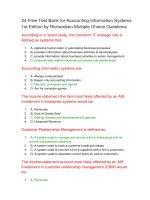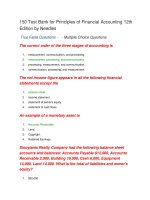151 test bank for principles of financial accounting 11th edition by needles
Bạn đang xem bản rút gọn của tài liệu. Xem và tải ngay bản đầy đủ của tài liệu tại đây (146.93 KB, 36 trang )
151 Test Bank for Principles of Financial Accounting 11th
Edition by Needles
Multiple Choice Questions-Page 1
The communication stage of accounting is accomplished by
1.
a.storing data.
2.
b.reporting to decision makers.
3.
c.processing data.
4.
d.recording data.
A company's ability to attract and hold investment capital ultimately depends
on its
1.
a.budgeting.
2.
b.planning.
3.
c.liquidity.
4.
d.profitability.
Companies listed on the stock exchanges must file financial statements with
the
1.
a.Financial Accounting Standards Board.
2.
b.American Institute of Certified Public Accountants.
3.
c.Securities and Exchange Commission.
4.
d.Internal Revenue Service.
Which of the following is an example of an operating activity?
1.
a.Obtaining capital from owners
2.
b.Selling goods and services to customers
3.
c.Purchasing equipment
4.
d.Selling land
An accounting measurement is concerned with all except which of the
following?
1.
a.Money measure
2.
b.Financial position
3.
c.Separate entity
4.
d.Business transaction
All of the following are considered nonexchange transactions except
1.
a.the day-by-day accumulation of interest.
2.
b.the wear and tear on machinery.
3.
c.the sale of goods and services.
4.
d.losses from fire, flood, and theft.
A primary user of accounting information with a direct financial interest in the
business is a
1.
a.regulatory agency.
2.
b.creditor.
3.
c.taxing authority.
4.
d.labor union.
The group of users of accounting information charged with achieving the
goals of the business is its
1.
a.auditors.
2.
b.creditors.
3.
c.management.
4.
d.investors.
The measurement stage of accounting is accomplished by
1.
a.recording data.
2.
b.reporting to decision makers.
3.
c.processing data.
4.
d.storing data.
Which of the following groups uses accounting information primarily to help
protect the public?
1.
a.Management
2.
b.Regulatory agencies
3.
c.Taxing authorities
4.
d.Economic planners
The separate entity concept requires that
1.
a.the personal assets and liabilities of an owner not be shown on the business's
financial statements.
2.
b.transactions that involve an exchange of value be kept separate from those that do
not.
3.
c.tax records be kept separate from financial reporting records.
4.
d.a separate set of books be established for each segment of a business.
Which of the following is the most appropriate and modern definition of
accounting?
1.
a.Electronic collection, organization, and communication of vast amounts of information
2.
b.The interconnected network of subsystems necessary to operate a business
3.
c.A means of recording transactions and keeping records
4.
d.The measurement, processing, and communication of financial information about an
identifiable economic entity
One user of accounting information with an indirect financial interest in a
business is
1.
a.a creditor.
2.
b.a financial adviser.
3.
c.management.
4.
d.an investor.
The topic of foreign exchange rates relates most closely to the concept of
1.
a.separate entity.
2.
b.money measure.
3.
c.nonexchange transactions.
4.
d.business transactions.
All of the following statements are true about the Sarbanes-Oxley Act except
1.
a.it applies to publicly traded companies.
2.
b.it shields chief executives from criminal penalties.
3.
c.it orders the SEC to draw up certain rules.
4.
d.its primary goal is to regulate financial reporting and the accounting profession.
Which of the following is an example of a financing activity?
1.
a.Employing workers
2.
b.Selling equipment
3.
c.Paying off a loan
4.
d.Purchasing land
Those who lend money or deliver goods and services before being paid are
called
1.
a.investors.
2.
b.debtors.
3.
c.underwriters.
4.
d.creditors.
Which of the following is an example of an investing activity?
1.
a.Purchasing a building
2.
b.Obtaining a bank loan
3.
c.Paying taxes to the government
4.
d.Producing goods and services
The intentional preparation of misleading financial statements, known as
fraudulent financial reporting, can result from all of the following except
1.
a.the misapplication of accounting principles.
2.
b.the manipulation of inventory records.
3.
c.fictitious sales or orders.
4.
d.recording a revenue that has been earned but not yet received.
Which of the following transactions does not involve an exchange of value?
1.
a.Payment of a debt
2.
b.Purchase of a building on credit
3.
c.Borrowing money
4.
d.Loss from theft
Which of the following is legally a separate entity from its owner(s)?
1.
a.Sole proprietorship only
2.
b.Sole proprietorship and partnership only
3.
c.Corporation only
4.
d.Partnership only
Which of the following transactions involves an exchange of value?
1.
a.Accumulation of interest
2.
b.Sale of services
3.
c.Flood loss
4.
d.Wear and tear on equipment
Which of the following is an agency of the U.S. government?
1.
a.IASB
2.
b.SEC
3.
c.FASB
4.
d.AICPA
The purchase of land is an example of a(n)
1.
a.investing activity.
2.
b.operating activity.
3.
c.capital activity.
4.
d.financing activity.
The correct order of the three stages of accounting is
1.
a.communication, processing, and measurement.
2.
b.measurement, communication, and processing.
3.
c.processing, measurement, and communication.
4.
d.measurement, processing, and communication.
54 Free Test Bank for Principles of Financial Accounting
11th Edition by Needles Multiple Choice Questions-Page
2
The purpose of an audit is to
1.
a.determine whether or not a company is a good investment.
2.
b.comply with income tax regulations.
3.
c.determine whether or not a company is a good credit risk.
4.
d.ascertain that the financial statements follow GAAP.
Which of the following is the correct accounting equation?
1.
a.Assets = Liabilities + Owner's Equity
2.
b.Assets + Owner's Equity = Liabilities
3.
c.Assets = Liabilities – Owner's Equity
4.
d.Assets + Liabilities = Owner's Equity
Standards for state and local governments are established by the
1.
a.IRS.
2.
b.IASB.
3.
c.GASB.
4.
d.AICPA.
Most business enterprises in the United States are
1.
a.government units.
2.
b.partnerships.
3.
c.sole proprietorships.
4.
d.corporations.
Generally accepted accounting principles
1.
a.are changing continually.
2.
b.are sound in theory but rarely used in practice.
3.
c.have eliminated all the weaknesses in accounting practice.
4.
d.are accounting rules formulated by the Internal Revenue Service.
Which of the following assets could be described as nonphysical?
1.
a.Buildings
2.
b.Cash
3.
c.Patents
4.
d.Equipment
The statement of cash flows would disclose the withdrawal of cash by the
owner
1.
a.in the financing activities section.
2.
b.in the investing activities section.
3.
c.in the operating activities section.
4.
d.nowhere on the statement.
All of the following statements about corporations are true, except
1.
a.they are chartered by the state.
2.
b.ownership is represented by shares of stock.
3.
c.the sale of stock does not dissolve the business.
4.
d.the stockholders have direct control of the business.
The audit committee is responsible for all of the following except
1.
a.engaging the company's independent auditors.
2.
b.assuring that reliable accounting records are kept.
3.
c.auditing the company's financial statements.
4.
d.ascertaining that the company safeguards its resources.
Which of the following is a regulatory agency?
1.
a.IASB
2.
b.SEC
3.
c.FASB
4.
d.GASB
All of the following statements about partnerships are true, except
1.
a.partners must share profits and losses equally.
2.
b.a change in ownership will dissolve the partnership.
3.
c.any partner can enter into a binding agreement with a third party.
4.
d.all partners have unlimited liability.
Which of the following items has no effect on owner's equity?
1.
a.Land purchased
2.
b.Revenue
3.
c.Expense
4.
d.Withdrawals
The statement of cash flows would disclose the purchase of a building for
cash
1.
a.nowhere on the statement.
2.
b.in the operating activities section.
3.
c.in the investing activities section.
4.
d.in the financing activities section.
An example of a monetary asset is
1.
a.Accounts Receivable.
2.
b.Copyright.
3.
c.Retained Earnings.
4.
d.Land.
The best definition of assets is the:
1.
a.cash owned by the company.
2.
b.resources belonging to a company having future benefit to the company.
3.
c.collection of resources belonging to the company and the claims on these resources.
4.
d.owner's investment in the business.
The development of international accounting standards is the primary
function of the
1.
a.IRS.
2.
b.AICPA.
3.
c.IASB.
4.
d.PCAOB.
The net income figure appears in all the following financial statements except
the
1.
a.statement of cash flows.
2.
b.income statement.
3.
c.statement of owner's equity.
4.
d.balance sheet.
Which of the following accounts is not considered an asset?
1.
a.Accounts Receivable
2.
b.Inventory
3.
c.Accounts Payable
4.
d.Trademark
Which of the following represents the proper order of financial statement
preparation?
1.
a.Statement of cash flows, balance sheet, income statement, statement of owner's
equity
2.
b.Statement of owner's equity, income statement, statement of cash flows, balance
sheet
3.
c.Balance sheet, statement of cash flows, statement of owner's equity, income
statement
4.
d.Income statement, statement of owner's equity, balance sheet, statement of cash
flows
All of the following items would appear on the balance sheet except
1.
a.withdrawals.
2.
b.the owner's Capital account.
3.
c.Accounts Receivable.
4.
d.Patents.
The authoritative body currently responsible for establishing accounting
practice is the
1.
a.Internal Revenue Service.
2.
b.Financial Accounting Standards Board.
3.
c.American Institute of Certified Public Accountants.
4.
d.Federal Reserve Board.
Carrying out professional responsibilities with competence and diligence is
called
1.
a.integrity.
2.
b.independence.
3.
c.objectivity.
4.
d.due care.
Which of the following forms of organization are considered to be separate
entities by accountants?
1.
a.Partnerships only
2.
b.Sole proprietorships only
3.
c.Corporations only
4.
d.Sole proprietorships, partnerships, and corporations
A liability would not include an obligation to
1.
a.transfer assets.
2.
b.hire an employee.
3.
c.pay cash.
4.
d.provide services.
An auditor maintains no direct financial interest in the company he or she is
auditing. The principle being followed is
1.
a.independence.
2.
b.integrity.
3.
c.objectivity.
4.
d.due care.
Which of the following financial statements is concerned with the enterprise
at a point in time?
1.
a.Statement of owner's equity
2.
b.Income statement
3.
c.Statement of cash flows
4.
d.Balance sheet
Which of the following is not one of the broad principles underlying the
accountant's code of professional ethics?
1.
a.Objectivity
2.
b.Integrity
3.
c.Loyalty
4.
d.Independence
Transfer of ownership will not affect the continuity of a
1.
a.corporation.
2.
b.sole proprietorship.
3.
c.partnership.
4.
d.corporation or partnership.
The Public Company Accounting Oversight Board was created by the
1.
a.Sarbanes-Oxley Act.
2.
b.GASB.
3.
c.IRS.
4.
d.IASB.
True-False Questions-Page 1
Creditors are those who lend money to others or deliver goods and services
before being paid.
1.
True
2.
False
Responsibility for ethical financial reporting rests solely with the accountant.
1.
True
2.
False
A major function of management is to provide the accountant with relevant
and useful information.
1.
True
2.
False
The primary external users of accounting information are investors and
management.
1.
True
2.
False
The Sarbanes-Oxley Act orders the SEC to hold chief executives and CFOs
responsible for the accuracy of their company's financial statements.
1.
True
2.
False
Accounting ratios are useful as management performance measures.
1.
True
2.
False
The evaluation and interpretation of financial statements and related
performance measures is called technical analysis.
1.
True
2.
False
The processing stage of accounting is accomplished by the recording of data.
1.
True
2.
False
Financial accounting information is used primarily by management.
1.
True
2.
False
The purchase of equipment is an example of a financing activity.
1.
True
2.
False
A company's management information system is a subsystem of its
accounting information system.
1.
True
2.
False
Regulatory agencies are considered information users with a direct financial
interest.
1.
True
2.
False
Paying taxes to the government is an example of an operating activity.
1.
True
2.
False
Management accounting focuses on external decision making.
1.
True
2.
False
Earned income is a measure of profitability.
1.
True
2.
False
Taxing authorities are considered accounting information users with an
indirect financial interest.
1.
True
2.
False
The terms bookkeeping and accounting are synonymous.
1.
True
2.
False
Obtaining funds from a bank is an example of an investing activity.
1.
True
2.
False
The Securities and Exchange Commission is an accounting information user
with a direct financial interest.
1.
True
2.
False
The intentional preparation of misleading financial statements is referred to as
fraudulent financial reporting.
1.
True
2.
False
Criminal penalties cannot be imposed on those who prepare fraudulent
financial statements.
1.
True
2.
False
Liquidity means having enough funds on hand to pay debts when they fall
due.
1.
True
2.
False
The modern definition of accounting focuses on the role of accounting in
making economic decisions rather than on how to do accounting.
1.
True
2.
False
Fraudulent financial reporting can result from the misapplication of
accounting principles.
1.
True
2.
False
The Federal Reserve Board is an example of an economic planner.
1.
True
2.
False
Two major goals of business are to achieve profitability and to achieve
liquidity.
1.
True
2.
False
Buying and selling goods and services are examples of operating activities.
1.
True
2.
False
84 Free Test Bank for Principles of Financial Accounting
11th Edition by Needles True-False Questions-Page 2
The stockholders of a corporation elect the board of directors.
1.
True
2.
False
The personal resources of any partner can be called upon to pay the
obligations of the partnership.
1.
True
2.
False
Accountants consider money the common unit of measure for all business
transactions.
1.
True
2.
False
When a corporate stockholder sells his or her shares of stock, the corporation
is technically dissolved.
1.
True
2.
False
Creditors' equities is another term for liabilities.
1.
True
2.
False
Net income is another term for revenues.
1.
True
2.
False
Not-for-profit organizations have no obligation to report their financial
performance to outside parties.
1.
True
2.
False
Cash is another term for owner's equity.
1.
True
2.
False
The liability of corporate stockholders is limited to the amount of their
investment.
1.
True
2.
False
Financial position may be assessed by referring to a balance sheet.
1.
True
2.
False
For reporting purposes, the personal assets and debts of a business owner
should be combined with the assets and debts of the business.
1.
True
2.
False
Corporations represent the largest number of businesses in the United
States.
1.
True
2.
False
Partnerships in the United States generate more business (in terms of
receipts) than sole proprietorships and corporations put together.
1.
True
2.
False
Financing a business means obtaining funds so the business can begin and
continue operating.
1.
True
2.
False
A partnership is dissolved when any partner leaves the business or dies.
1.
True
2.
False
For accounting purposes, a business and its owners are considered separate
entities.
1.
True
2.
False
Equipment is an asset that is considered nonmonetary in nature.
1.
True
2.
False
A corporation is an economic unit that is legally separate from its owners.
1.
True
2.
False
Only about 10 percent of the U.S. economy is generated by governmental and
not-for-profit organizations.
1.
True
2.
False
Knowledge of the exchange rate is necessary to apply the money measure
concept in case of international transactions.
1.
True
2.
False
Revenues have the effect of increasing owner's capital.
1.
True
2.
False
A net loss results when owner's withdrawals exceed net income.
1.
True
2.
False
In general, any partner can obligate the partnership to another party.
1.
True
2.
False
The economic resources invested in a business by the owner are represented
by owner's equity.
1.
True









